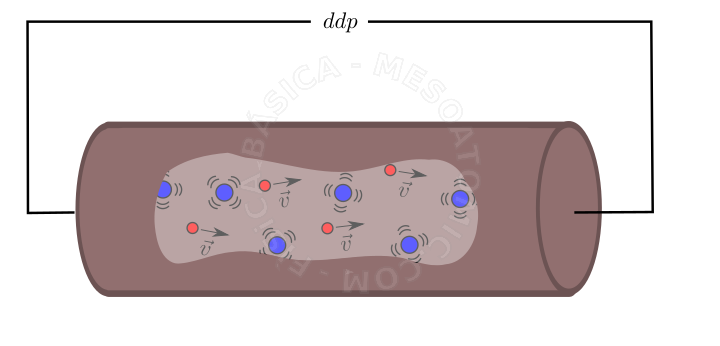- Electromagnetism
- /
- Electrodynamics
- /
- Electric currents
Electrical appliances work due to electrical currents that are ordered flows of electrons. However, the charges of the currents are not consumed in the device, i.e., electrons do not disappear within the apparatus; what is consumed is the energy carried by the current.
Electric Current
The following definitions are important:
- Conductor:
- It is the material or substance with free charges, or charges that are easily moved by the action of electrical forces acting inside the material.
- Electric current:
- An electric current is an orderly motion of free charges in a conductor, which is generated by a \(\mathbb{V}\) applied between two points of the conductor. See the illustration below.

Illustration of an electric current that appears on a cylindrical conductor due to the application of a \(\mathbb{V}\) . The red balls represent the free electrons and the blue balls atoms or molecules. - Real Direction of the Electric Current:
- A conductor is filled with free electrons. The current direction is the direction of displacement of these charges. However, the convention is to use the opposite direction of the movement of electrons.
- Conventional Current:
- It is the imaginary current of positive charges in a solid conductor.
- Average Intensity of Electric Current:
- It is the amount of charge \(Q\) running through one cross-section of the conductor in a time interval \(\Delta t\) , that is: $$ i = \frac{Q}{\Delta t}.$$
- Driving Current:
- It is the movement of electrons in solid conductors.
- Convection Current:
- It is the movement of positive and negative ions in conductive liquids, for example, electrolytes and gas conductors. In this scenario, there is a movement of all types of charges: positive ions, negative ions, and free electrons.
- The \(IS\) unit of electrical current is Ampere \((A)\) ,i.e., \([i] = A = \frac{C}{s}\) .
Conditions For The Emergence And Maintenance Of An Electric Current
- Closed loop (closed path).
- Existence of a force acting on electric charges.
- Existence of "free" charges.
Types of Electric Current
- Alternating Current:
- It is generated by an electric field that periodically reverses direction, so that the current is negative at a given time interval and on the next interval, positive. In this type of current, charges have vibratory movements.

Graph \(i \times t\) of an alternating current. - Direct Current:
- It is one whose direction of current flow never changes and the intensity can change or not.

Graph \(i \times t\) a constant direct current. - Rectified Current:
- It is a direct current of variable intensity. It can be obtained from an alternating current, through a rectifier devices.

Graph \(i \times t\) a rectified current.
The Electric Current Effects
- Joule Effect:
- It is the thermal effect, which occurs when an electric current passes through a conductor and heat is generated. The temperature increase is due to collisions between moving electrons and the molecules, these collisions increase vibrations of molecules. (Remember that an increase in temperature is associated with a higher molecular agitation). For example, when you use your smartphone or tablet, it can get very hot, because the more we use it, the more it drains current from its battery, and the Joule effect heats the device.
- Magnetic Effect:
- This happens when a conductor is traversed by an electric current, generating in their vicinity a magnetic field.
- Chemical Effect:
- They are the chemical reactions that are caused by the passage of electric current through an electrolyte.
- Luminous Effect:
- Gases, when an electrical current passes through them, are ionized and emit light. These light emissions are called luminous effect of electric currents.
- Physiological Effects:
- The electric current, when it goes through a living organism, can cause extensive damage, depending on the current intensity. There may be interference with nerve impulses, and therefore, involuntary muscle contractions. It can also cause heat generation (Joule effect) and burn the organism tissues.
